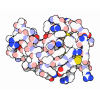+ Open data
Open data
- Basic information
Basic information
| Entry | Database: PDB / ID: 2q76 | ||||||
|---|---|---|---|---|---|---|---|
| Title | Mouse anti-hen egg white lysozyme antibody F10.6.6 Fab fragment | ||||||
 Components Components |
| ||||||
 Keywords Keywords | IMMUNE SYSTEM / Antibody / Fab fragment / lysozyme / affinity maturation / VH-VL interface. | ||||||
| Function / homology |  Function and homology information Function and homology information | ||||||
| Biological species |  | ||||||
| Method |  X-RAY DIFFRACTION / X-RAY DIFFRACTION /  SYNCHROTRON / SYNCHROTRON /  MOLECULAR REPLACEMENT / Resolution: 2 Å MOLECULAR REPLACEMENT / Resolution: 2 Å | ||||||
 Authors Authors | Cauerhff, A. / Klinke, S. / Acierno, J.P. / Goldbaum, F.A. / Braden, B.C. | ||||||
 Citation Citation |  Journal: J.Mol.Biol. / Year: 2007 Journal: J.Mol.Biol. / Year: 2007Title: Affinity maturation increases the stability and plasticity of the Fv domain of anti-protein antibodies. Authors: Acierno, J.P. / Braden, B.C. / Klinke, S. / Goldbaum, F.A. / Cauerhff, A. #1:  Journal: Proc.Natl.Acad.Sci.USA / Year: 2004 Journal: Proc.Natl.Acad.Sci.USA / Year: 2004Title: Structural mechanism for affinity maturation of an anti-lysozyme antibody Authors: Cauerhff, A. / Goldbaum, F.A. / Braden, B.C. | ||||||
| History |
| ||||||
| Remark 999 | sequence The sequences for Fab F10.6.6 fragment Light and heavy chains are not in the UNP database ...sequence The sequences for Fab F10.6.6 fragment Light and heavy chains are not in the UNP database at the time of processing. Author indicated the sequence references AF110316.3 GI:32456055 for VH, and AY277254.1 GI:33642144 for VL, respectively. Both sequences are identical to the sequences in the coordinates. |
- Structure visualization
Structure visualization
| Structure viewer | Molecule:  Molmil Molmil Jmol/JSmol Jmol/JSmol |
|---|
- Downloads & links
Downloads & links
- Download
Download
| PDBx/mmCIF format |  2q76.cif.gz 2q76.cif.gz | 181 KB | Display |  PDBx/mmCIF format PDBx/mmCIF format |
|---|---|---|---|---|
| PDB format |  pdb2q76.ent.gz pdb2q76.ent.gz | 144.9 KB | Display |  PDB format PDB format |
| PDBx/mmJSON format |  2q76.json.gz 2q76.json.gz | Tree view |  PDBx/mmJSON format PDBx/mmJSON format | |
| Others |  Other downloads Other downloads |
-Validation report
| Summary document |  2q76_validation.pdf.gz 2q76_validation.pdf.gz | 447.2 KB | Display |  wwPDB validaton report wwPDB validaton report |
|---|---|---|---|---|
| Full document |  2q76_full_validation.pdf.gz 2q76_full_validation.pdf.gz | 471.3 KB | Display | |
| Data in XML |  2q76_validation.xml.gz 2q76_validation.xml.gz | 39.5 KB | Display | |
| Data in CIF |  2q76_validation.cif.gz 2q76_validation.cif.gz | 56.5 KB | Display | |
| Arichive directory |  https://data.pdbj.org/pub/pdb/validation_reports/q7/2q76 https://data.pdbj.org/pub/pdb/validation_reports/q7/2q76 ftp://data.pdbj.org/pub/pdb/validation_reports/q7/2q76 ftp://data.pdbj.org/pub/pdb/validation_reports/q7/2q76 | HTTPS FTP |
-Related structure data
| Related structure data | 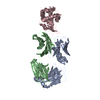 1p2cS S: Starting model for refinement |
|---|---|
| Similar structure data |
- Links
Links
- Assembly
Assembly
| Deposited unit | 
| ||||||||
|---|---|---|---|---|---|---|---|---|---|
| 1 | 
| ||||||||
| 2 | 
| ||||||||
| Unit cell |
|
- Components
Components
| #1: Antibody | Mass: 23320.539 Da / Num. of mol.: 2 / Fragment: domain VL and CL / Source method: isolated from a natural source Details: The antibody was obtained from ascitic fluid generated by injecting monoclonal hybridoma cells. Source: (natural)  #2: Antibody | Mass: 23198.896 Da / Num. of mol.: 2 / Fragment: domain VH and CH1 / Source method: isolated from a natural source Details: The antibody was obtained from ascitic fluid generated by injecting monoclonal hybridoma cells. Source: (natural)  #3: Water | ChemComp-HOH / | Has protein modification | Y | |
|---|
-Experimental details
-Experiment
| Experiment | Method:  X-RAY DIFFRACTION / Number of used crystals: 1 X-RAY DIFFRACTION / Number of used crystals: 1 |
|---|
- Sample preparation
Sample preparation
| Crystal | Density Matthews: 2.14 Å3/Da / Density % sol: 42.63 % |
|---|---|
| Crystal grow | Temperature: 298 K / Method: vapor diffusion, hanging drop / pH: 4.7 Details: The F10.6.6 Fab fragment was crystallized in a mother liquor containing 24% (w/v) PEG 1000, 0.2 M CaCl2 and 0.1 M acetate buffer pH 4.7. Large prisms of about 0.30 mm x 0.05 mm x 0.05 mm ...Details: The F10.6.6 Fab fragment was crystallized in a mother liquor containing 24% (w/v) PEG 1000, 0.2 M CaCl2 and 0.1 M acetate buffer pH 4.7. Large prisms of about 0.30 mm x 0.05 mm x 0.05 mm were obtained after several weeks. VAPOR DIFFUSION, HANGING DROP, temperature 298K, pH 4.70 |
-Data collection
| Diffraction | Mean temperature: 100 K |
|---|---|
| Diffraction source | Source:  SYNCHROTRON / Site: SYNCHROTRON / Site:  LNLS LNLS  / Beamline: D03B-MX1 / Wavelength: 1.431 Å / Beamline: D03B-MX1 / Wavelength: 1.431 Å |
| Detector | Type: MAR CCD 165 mm / Detector: CCD / Date: May 14, 2003 |
| Radiation | Monochromator: SI SINGLE CRYSTAL / Protocol: SINGLE WAVELENGTH / Monochromatic (M) / Laue (L): M / Scattering type: x-ray |
| Radiation wavelength | Wavelength: 1.431 Å / Relative weight: 1 |
| Reflection | Resolution: 2→50 Å / Num. all: 50300 / Num. obs: 50300 / % possible obs: 96 % / Observed criterion σ(F): 0 / Observed criterion σ(I): 0 / Redundancy: 8.1 % / Biso Wilson estimate: 19.3 Å2 / Rmerge(I) obs: 0.069 / Rsym value: 0.069 / Net I/σ(I): 9.8 |
| Reflection shell | Resolution: 2→2.07 Å / Redundancy: 8.2 % / Rmerge(I) obs: 0.195 / Mean I/σ(I) obs: 3.3 / Num. unique all: 7122 / Rsym value: 0.195 / % possible all: 92 |
- Processing
Processing
| Software |
| |||||||||||||||
|---|---|---|---|---|---|---|---|---|---|---|---|---|---|---|---|---|
| Refinement | Method to determine structure:  MOLECULAR REPLACEMENT MOLECULAR REPLACEMENTStarting model: Fab fragment of PDB 1P2C Resolution: 2→50 Å / Cross valid method: THROUGHOUT / σ(F): 2 / Stereochemistry target values: Engh & Huber
| |||||||||||||||
| Displacement parameters | Biso mean: 22 Å2 | |||||||||||||||
| Refinement step | Cycle: LAST / Resolution: 2→50 Å
| |||||||||||||||
| Refine LS restraints |
|
 Movie
Movie Controller
Controller




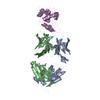
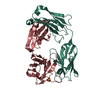
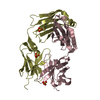
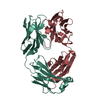






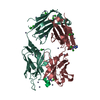
 PDBj
PDBj


